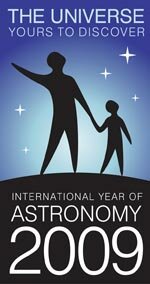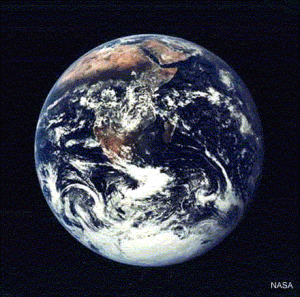2009 – The International Year of Astronomy
By Dayib Atto — The year 2009 has been designated as the international year of Astronomy commemorating the night four hundred years ago when Galileo Galilei peered through his telescope into the night, and saw things in the sky that no human has ever seen before, moons orbiting other planets, moons and planets that seemed to move, visions that brought the wrath and punishment of the ruling theocracy of the Vatican upon him, what he saw with his own eyes was condemned by men of ‘God’ who never looked up as he did, but only looked down and near to read from the holy scriptures, and forced him to recant and deny his own scientific discovery, and then condemned him to a lifetime of house arrest.
 With that simple act of using his telescope, Galileo opened the gate to the heavens for the modern exploration of the Universe, and as we all know now, Copernicus was right t as proven by Galileo’s observations, and it was only the year 1992 when at last the Vatican apologized for what was done to Galileo in the name of Religion, and nodded in agreement that after all he was damn right when he said “Eppur si muove..”, and that at least in this neighborhood of the Milky Way galaxy, it was both Earth and Moon and with all the other Planets and their Moons and all other objects in her realm that revolved around the Sun and ruled by its massive influence (more than a million earths can fit inside the sun), but not the other way around where the Stars and the Sun were thought to revolve around the Earth.
With that simple act of using his telescope, Galileo opened the gate to the heavens for the modern exploration of the Universe, and as we all know now, Copernicus was right t as proven by Galileo’s observations, and it was only the year 1992 when at last the Vatican apologized for what was done to Galileo in the name of Religion, and nodded in agreement that after all he was damn right when he said “Eppur si muove..”, and that at least in this neighborhood of the Milky Way galaxy, it was both Earth and Moon and with all the other Planets and their Moons and all other objects in her realm that revolved around the Sun and ruled by its massive influence (more than a million earths can fit inside the sun), but not the other way around where the Stars and the Sun were thought to revolve around the Earth.
So in remembrance to Galileo and his telescope, this year the curious all over the world are making preparations for a unique summer of Astronomy, to observe and celebrate the wonders of the night skies.
With the multitudes of more pressing issues facing our people in mind, its nonetheless my hope that Somali children all over the world are encouraged this year to look up and wonder at the mysterious beauty of the stars in the clear sky of moonless nights.
 As a child I was in that lucky generation that grew up in Somalia in her narrow window of relative peace, and had the opportunity and the curiosity to look at the night sky, and saw the gleaming, flickering, shimmering starry clouds of the Milky Way, mighty clouds of light that in some places appeared to form ridges and peaks and valleys in the sky, and was always thrilled by the zooming streak of light from the occasional falling star.
As a child I was in that lucky generation that grew up in Somalia in her narrow window of relative peace, and had the opportunity and the curiosity to look at the night sky, and saw the gleaming, flickering, shimmering starry clouds of the Milky Way, mighty clouds of light that in some places appeared to form ridges and peaks and valleys in the sky, and was always thrilled by the zooming streak of light from the occasional falling star.
My earliest memory of childhood interest in Astronomy was the appearance of a what I now assume to have been a comet, a bright smudge that appeared on the western sky over Kismayo that I think lasted for more than a week, a phenomena which was at the time explained to us by the elders to have been a clear heavenly sign on the death of a local Holy man (I think it was Sheekh Nuur’s), – a welcoming celestial fireworks for the saint?
Later on, from the shelves of the library of the American Embassy in Mogadishu I found Astronomy books, books with strange titles like ‘The Collapsing Universe’ by Isac Asimov – a title that grabbed my attention like a magnet – , and from there I was introduced into the world of Nebulae and Galaxies, Super Novas and Black Holes, Pulsars and Quasars, the Big Bang and the magnificent possibility of life existing elsewhere across the sky on other worlds, and I was intrigued, and I was hooked.
Some of what I saw then as mere stars, later I learned they were much more than that, sometimes like a far away cloud of dust and gas in a distant corner of the sky where new stars are reborn from the recycled material of stars from earlier generation that died in colossal explosions, other times like distant galaxies consisting of millions of millions of suns , some of them hundreds of times larger than our own sun, yet due to the unimaginable distances from us looked like a faint point of light to the naked eye.
Another interesting side of Astronomy is the perplexing quandary of Time and Space, the insanely mind bending thought of actually seeing things now as they were a long time yesterday, with the probability that some of the stars that we see now have died thousands, millions or more of years ago, and what we are seeing tonight is how these stars were when the light hitting our eyes was emitted from the star, a vastness of space and time spanning maybe hundreds of millions of years.
Even the Sun, we don’t see it now in her present state, but we see it as it was eight minutes ago, the amount of time it takes light to travel between the Sun and Earth.
 Motion in dizzying speeds seems to be the rule of the Cosmos, nothing is at rest, everything is in a constant flight at very high speeds, with light being the express courier delivering the news in relative time. Consider this: Even now as we sit at the coffee shop doing the “fadhi-ku-dirir†or sleeping tonight after a long day’s work, there is no resting for us in space, we are all the time hurling through space at the speed of 100,000 km or 62,000 miles per hour around the Sun, and at the equator, in Kismayo and Mogadishu we are also rotationally spinning at the speed of over     620 km or over 1000 miles an hour, in short we live on top the very thing crust of the somewhat cooled surface of this massive ball that was hurled into existence a very long time ago, still going whirling and spinning.
Motion in dizzying speeds seems to be the rule of the Cosmos, nothing is at rest, everything is in a constant flight at very high speeds, with light being the express courier delivering the news in relative time. Consider this: Even now as we sit at the coffee shop doing the “fadhi-ku-dirir†or sleeping tonight after a long day’s work, there is no resting for us in space, we are all the time hurling through space at the speed of 100,000 km or 62,000 miles per hour around the Sun, and at the equator, in Kismayo and Mogadishu we are also rotationally spinning at the speed of over     620 km or over 1000 miles an hour, in short we live on top the very thing crust of the somewhat cooled surface of this massive ball that was hurled into existence a very long time ago, still going whirling and spinning.
Comments
comments
 Calendar
Calendar




































